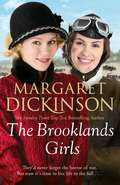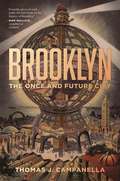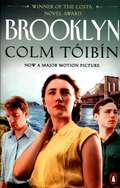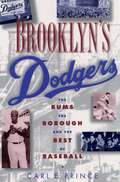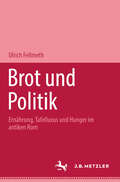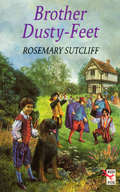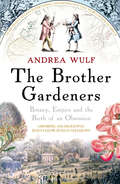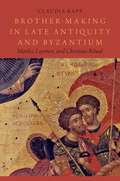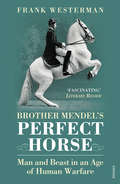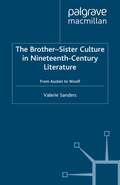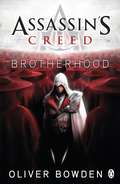- Table View
- List View
The Brooklands Girls (The Maitland Trilogy #2)
by Margaret DickinsonThe Brooklands Girls is the heartfelt sequel to The Poppy Girls from Margaret Dickinson, the Sunday Times top ten bestselling ‘Queen of Saga’ (Daily Express)It is the early 1920s and the Maitland family are still coming to terms with the aftermath of the Great War. After her brave work as an ambulance driver and nurse close to the Front, Pips is restless and without purpose. Determined to enjoy life after the years of misery, and to help her forget a broken love affair, she seeks excitement in the London parties and balls of the Roaring Twenties.No family or community escaped the ravages of this war, and Pips knows her own has its share of troubles. Her brother, Robert, returned injured and is now battling demons of his own. Struggling to find a purpose in life, he is convinced his career as a doctor is over. It is Pips’s young niece, Daisy, on whom the family dotes, who brings them joy and hope for the future.But when faces from the past reappear, Pips is posed with a dilemma. Can she ever trust a man’s promises and allow herself to love again?Fans of Dilly Court and Rosie Goodwin will love The Brooklands Girls.
Brooklyn: The Once and Future City
by Thomas CampanellaAn unprecedented history of Brooklyn, told through its places, buildings, and the people who made them, from the early seventeenth century to todayAmerica's most storied urban underdog, Brooklyn has become an internationally recognized brand in recent decades—celebrated and scorned as one of the hippest destinations in the world. In Brooklyn: The Once and Future City, Thomas J. Campanella unearths long-lost threads of the urban past, telling the rich history of the rise, fall, and reinvention of one of the world’s most resurgent cities.Spanning centuries and neighborhoods, Brooklyn-born Campanella recounts the creation of places familiar and long forgotten, both built and never realized, bringing to life the individuals whose dreams, visions, rackets, and schemes forged the city we know today. He takes us through Brooklyn’s history as homeland of the Leni Lenape and its transformation by Dutch colonists into a dense slaveholding region. We learn about English émigré Deborah Moody, whose town of Gravesend was the first founded by a woman in America. We see how wanderlusting Yale dropout Frederick Law Olmsted used Prospect Park to anchor an open space system that was to reach back to Manhattan. And we witness Brooklyn’s emergence as a playland of racetracks and amusement parks celebrated around the world.Campanella also describes Brooklyn’s outsized failures, from Samuel Friede’s bid to erect the world’s tallest building to the long struggle to make Jamaica Bay the world’s largest deepwater seaport, and the star-crossed urban renewal, public housing, and highway projects that battered the borough in the postwar era. Campanella reveals how this immigrant Promised Land drew millions, fell victim to its own social anxieties, and yet proved resilient enough to reawaken as a multicultural powerhouse and global symbol of urban vitality.
Brooklyn
by Colm TóibínBrooklyn is a devastating story of love, loss and one woman's terrible choice between duty and personal freedom. It is Ireland in the early 1950s and for Eilis Lacey, as for so many young Irish girls, opportunities are scarce. So when her sister arranges for her to emigrate to New York, Eilis knows she must go, leaving behind her family and her home for the first time.Arriving in a crowded lodging house in Brooklyn, Eilis can only be reminded of what she has sacrificed. She is far from home - and homesick. And just as she takes tentative steps towards friendship, and perhaps something more, Eilis receives news which sends her back to Ireland. There she will be confronted by a terrible dilemma - a devastating choice between duty and one great love.'With this elating and humane novel, Colm Tóibín has produced a masterwork' Sunday Times 'The most compelling and moving portrait of a young woman I have read in a long time' Zoë Heller Guardian, Books of the Year 'A work of such skill, understatement and sly jewelled merriment could haunt your life' Ali Smith, TLS, Books of the YearWhen you are finished why not read the companion novel Nora Webster.
Brooklyn Before: Photographs, 1971–1983
by Larry RacioppoBefore Brooklyn rose to international fame there existed a vibrant borough of neighborhoods rich with connections and traditions. During the 1970s and 1980s, photographer Larry Racioppo, a South Brooklynite with roots three generations deep, recorded Brooklyn on the cusp of being the trendy borough we know today.In Brooklyn Before, Racioppo lets us see the vitality of his native Brooklyn, stretching from historic Park Slope to the beginnings of Windsor Terrace and Sunset Park. His black and white photographs pull us deep into the community, stretching our memories back more than forty years and teasing out the long-lost recollections of life on the streets and in apartment homes. Racioppo has the fascinating ability to tell a story in one photograph and, because of his native bona fides, he depicts an intriguing set of true Brooklyn stories from the inside, in ways that an outsider simply cannot. On the pages of, Brooklyn Before the intimacy and roughness of life in a working-class community of Irish American, Italian American, and Puerto Rican families is shown with honesty and insight.Racioppo's 128 photographs are paired with essays from journalist Tom Robbins and art critic and curator Julia Van Haaften. Taken together, the images and words of Brooklyn Before return us to pre-gentrification Brooklyn and immerse us in a community defined by work, family, and ethnic ties.
Brooklyn (PDF)
by Colm ToibinIt is Ireland in the early 1950s and for Eilis Lacey, as for so many young Irish girls, opportunities are scarce. So when her sister arranges for her to emigrate to New York, Eilis knows she must go. Arriving in a crowded lodging house in Brooklyn, Eilis can only be reminded of what she has sacrificed. And just as she takes tentative steps towards friendship, and perhaps something more, Eilis receives news which sends her back to Ireland. There she will be confronted by a terrible dilemma - a devastating choice between duty and one great love.
Brooklyn's Dodgers: The Bums, the Borough, and the Best of Baseball, 1947-1957
by Carl E. PrinceDuring the 1952 World Series, a Yankee fan trying to watch the game in a Brooklyn bar was told, "Why don't you go back where you belong, Yankee lover?" "I got a right to cheer my team," the intruder responded, "this is a free country." "This ain't no free country, chum," countered the Dodger fan, "this is Brooklyn." Brooklynites loved their "Bums"--Pee Wee Reese, Jackie Robinson, Duke Snider, Roy Campanella, and all the murderous parade of regulars who, after years of struggle, finally won the World Series in 1955. One could not live in Brooklyn and not catch its spirit of devotion to its baseball club. In Brooklyn's Dodgers, Carl E. Prince captures the intensity and depth of the team's relationship to the community and its people in the 1950s. Ethnic and racial tensions were part and parcel of a working class borough; the Dodgers' presence smoothed the rough edges of the ghetto conflict always present in the life of Brooklyn. The Dodger-inspired baseball program at the fabled Parade Grounds provided a path for boys that occasionally led to the prestigious "Dodger Rookie Team," and sometimes, via minor league contracts, to Ebbets Field itself. There were the boys who lined Bedford Avenue on game days hoping to retrieve home run balls and the men in the many bars who were not only devoted fans but collectively the keepers of the Dodger past--as were Brooklyn women, and in numbers. Indeed, women were tied to the Dodgers no less than their husbands, fathers, brothers, and sons; they were only less visible. A few, like Pulitzer Prize-winning poet Marianne Moore and working class stiff Hilda Chester were regulars at Ebbets Field and far from invisible. Prince also explores the underside of the Dodgers--the "baseball Annies," and the paternity suits that went with the territory. The Dodgers' male culture was played out as well in the team's politics, in the owners' manipulation of Dodger male egos, opponents' race-baiting, and the macho bravado of the team (how Jackie Robinson, for instance, would prod Giants' catcher Sal Yvars to impotent rage by signaling him when he was going to steal second base, then taunting him from second after the steal). The day in 1957 when Walter O'Malley, the owner of the Brooklyn Dodgers, announced that the team would be leaving for Los Angeles was one of the worst moments in baseball history, and a sad day in Brooklyn's history as well. The Dodger team was, to a degree unmatched in other major league cities, deeply enmeshed in the life and psyche of Brooklyn and its people. In this superb volume, Carl Prince illuminates this "Brooklyn" in the golden years after the Second World War.
Brooklyn's Dodgers: The Bums, the Borough, and the Best of Baseball, 1947-1957
by Carl E. PrinceDuring the 1952 World Series, a Yankee fan trying to watch the game in a Brooklyn bar was told, "Why don't you go back where you belong, Yankee lover?" "I got a right to cheer my team," the intruder responded, "this is a free country." "This ain't no free country, chum," countered the Dodger fan, "this is Brooklyn." Brooklynites loved their "Bums"--Pee Wee Reese, Jackie Robinson, Duke Snider, Roy Campanella, and all the murderous parade of regulars who, after years of struggle, finally won the World Series in 1955. One could not live in Brooklyn and not catch its spirit of devotion to its baseball club. In Brooklyn's Dodgers, Carl E. Prince captures the intensity and depth of the team's relationship to the community and its people in the 1950s. Ethnic and racial tensions were part and parcel of a working class borough; the Dodgers' presence smoothed the rough edges of the ghetto conflict always present in the life of Brooklyn. The Dodger-inspired baseball program at the fabled Parade Grounds provided a path for boys that occasionally led to the prestigious "Dodger Rookie Team," and sometimes, via minor league contracts, to Ebbets Field itself. There were the boys who lined Bedford Avenue on game days hoping to retrieve home run balls and the men in the many bars who were not only devoted fans but collectively the keepers of the Dodger past--as were Brooklyn women, and in numbers. Indeed, women were tied to the Dodgers no less than their husbands, fathers, brothers, and sons; they were only less visible. A few, like Pulitzer Prize-winning poet Marianne Moore and working class stiff Hilda Chester were regulars at Ebbets Field and far from invisible. Prince also explores the underside of the Dodgers--the "baseball Annies," and the paternity suits that went with the territory. The Dodgers' male culture was played out as well in the team's politics, in the owners' manipulation of Dodger male egos, opponents' race-baiting, and the macho bravado of the team (how Jackie Robinson, for instance, would prod Giants' catcher Sal Yvars to impotent rage by signaling him when he was going to steal second base, then taunting him from second after the steal). The day in 1957 when Walter O'Malley, the owner of the Brooklyn Dodgers, announced that the team would be leaving for Los Angeles was one of the worst moments in baseball history, and a sad day in Brooklyn's history as well. The Dodger team was, to a degree unmatched in other major league cities, deeply enmeshed in the life and psyche of Brooklyn and its people. In this superb volume, Carl Prince illuminates this "Brooklyn" in the golden years after the Second World War.
Brooklyn’s Renaissance: Commerce, Culture, and Community in the Nineteenth-Century Atlantic World
by Melissa Meriam BullardThis book shows how modern Brooklyn’s proud urban identity as an arts-friendly community originated in the mid nineteenth century. Before and after the Civil War, Brooklyn’s elite, many engaged in Atlantic trade, established more than a dozen cultural societies, including the Philharmonic Society, Academy of Music, and Art Association. The associative ethos behind Brooklyn’s fine arts flowering built upon commercial networks that joined commerce, culture, and community. This innovative, carefully researched and documented history employs the concept of parallel Renaissances. It shows influences from Renaissance Italy and Liverpool, then connected to New York through regular packet service like the Black Ball Line that ferried people, ideas, and cargo across the Atlantic. Civil War disrupted Brooklyn’s Renaissance. The city directed energies towards war relief efforts and the women’s Sanitary Fair. The Gilded Age saw Brooklyn’s Renaissance energies diluted by financial and political corruption, planning the Brooklyn Bridge and consolidation with New York City in 1898.
Brooklyn’s Renaissance: Commerce, Culture, and Community in the Nineteenth-Century Atlantic World
by Melissa Meriam BullardThis book shows how modern Brooklyn’s proud urban identity as an arts-friendly community originated in the mid nineteenth century. Before and after the Civil War, Brooklyn’s elite, many engaged in Atlantic trade, established more than a dozen cultural societies, including the Philharmonic Society, Academy of Music, and Art Association. The associative ethos behind Brooklyn’s fine arts flowering built upon commercial networks that joined commerce, culture, and community. This innovative, carefully researched and documented history employs the concept of parallel Renaissances. It shows influences from Renaissance Italy and Liverpool, then connected to New York through regular packet service like the Black Ball Line that ferried people, ideas, and cargo across the Atlantic. Civil War disrupted Brooklyn’s Renaissance. The city directed energies towards war relief efforts and the women’s Sanitary Fair. The Gilded Age saw Brooklyn’s Renaissance energies diluted by financial and political corruption, planning the Brooklyn Bridge and consolidation with New York City in 1898.
The ‘Broomhandle’ Mauser (Weapon #58)
by Peter Dennis Jonathan FergusonAt a time when most handguns were limited to six rounds, the ten-shot Mauser caught the attention of the world for its unprecedented firepower and formidable high-velocity 7.63×25mm cartridge. This saw its ultimate expression in the first-ever select-fire handgun – the 'Schnellfeuer' machine pistol, fed by a detachable magazine and offering both full-automatic and single-shot modes. The C 96 was the first semi-automatic pistol to see combat, arming both sides in the Second Anglo-Boer War, and seeing service with the German, Russian, Chinese and other militaries. Widely purchased commercially, it was carried by none other than Winston Churchill in the Sudan and South Africa, became prized by the Irish Republican Army and Soviet revolutionaries, and even armed Han Solo in the 'Star Wars' movies.Featuring full-colour artwork and an array of revealing photographs, this is the engrossing story of the C 96 Broomhandle Mauser, the ground-breaking semi-automatic pistol that armed a generation of military personnel, adventurers and revolutionaries at the turn of the 20th century.
The ‘Broomhandle’ Mauser (Weapon #58)
by Peter Dennis Jonathan FergusonAt a time when most handguns were limited to six rounds, the ten-shot Mauser caught the attention of the world for its unprecedented firepower and formidable high-velocity 7.63×25mm cartridge. This saw its ultimate expression in the first-ever select-fire handgun – the 'Schnellfeuer' machine pistol, fed by a detachable magazine and offering both full-automatic and single-shot modes. The C 96 was the first semi-automatic pistol to see combat, arming both sides in the Second Anglo-Boer War, and seeing service with the German, Russian, Chinese and other militaries. Widely purchased commercially, it was carried by none other than Winston Churchill in the Sudan and South Africa, became prized by the Irish Republican Army and Soviet revolutionaries, and even armed Han Solo in the 'Star Wars' movies.Featuring full-colour artwork and an array of revealing photographs, this is the engrossing story of the C 96 Broomhandle Mauser, the ground-breaking semi-automatic pistol that armed a generation of military personnel, adventurers and revolutionaries at the turn of the 20th century.
Brot und Politik: Ernährung, Tafelluxus und Hunger im antiken Rom
by Ulrich FellmethWenn die Getreidelieferungen aus den Provinzen ausblieben, wurde es für 95 Prozent der Bevölkerung des antiken Rom eng; nur eine dünne Oberschicht konnte den sprichwörtlichen Tafelluxus der Römer zelebrieren. Die Ernährungsgewohnheiten, die Hungerkrisen mit ihren Ursachen und Konsequenzen und die Reaktionen der Politik sind Thema dieses Buches.
Brother Cadfael: The Complete Chronicles
by Ellis PetersTHE COMPLETE CADFAEL CHRONICLES: 21 ebooks in one. Seventy years have passed since the conquest of England by William of Normandy. But following the death of Henry I, with no male heir, the country is divided – the armies of Henry's daughter the Empress Maud and her cousin, King Stephen, mass to the West and East. Each would claim the crown. Beset by civil strife, caught between Stephen's forces and the kingdoms of Wales, life in the border town of Shrewsbury continues as best it can. Even the Benedictine brothers of the Order of St Peter and St Paul cannot escape the encroaching war. And more often than not, the Abbey herbalist, a healer and skilled observer of human nature, Brother Cadfael, is called upon to use his more worldly talents in pursuit of justice. Cadfael ap Meilyr ap Dafydd (known simply as Brother Cadfael) is a Welsh monk, herbalist and apothecary of Shrewsbury Abbey. He entered the Benedictine order in 1120 after sixteen years in the armies of Britain and Normandy. As a soldier and sea captain he fought in the Holy Land, serving at the fall of Antioch and the storming of Jerusalem. As a young man, he was betrothed to Richildis Gurney, but never married. He has an illegitimate son, Olivier de Bretagne, by the Saracen widow Mariam of Antioch.This ebook contains:A RARE BENEDICTINE: The Advent of Brother Cadfael. A MORBID TASTE FOR BONES. ONE CORPSE TOO MANY. MONK'S HOOD. SAINT PETER'S FAIR. THE LEPER OF SAINT GILES. THE VIRGIN IN THE ICE. THE SANCTUARY SPARROW. THE DEVIL'S NOVICE. DEAD MAN'S RANSOM. THE PILGRIM OF HATE. AN EXCELLENT MYSTERY. THE RAVEN IN THE FOREGATE. THE ROSE RENT. THE HERMIT OF EYTON FOREST. THE CONFESSION OF BROTHER HALUIN. THE HERETIC'S APPRENTICE. THE POTTER'S FIELD. THE SUMMER OF THE DANES. THE HOLY THIEF. BROTHER CADFAEL'S PENANCE.
Brother Cadfael's Penance (The Cadfael Chronicles #20)
by Ellis PetersNovember, 1145. The bitter rift between King Stephen and Empress Maud at last has a chance of reconciliation. Brother Cadfael is faced with a shocking revelation: one of the hostages is his illegitimate son.
Brother Dusty Feet (Red Fox Older Fiction Ser.)
by Rosemary SutcliffAlong with his faithful dog Argos, eleven-year-old Hugh Copplestone decides to leave his Aunt and Uncle's house after one beating too many, and heads for Oxford to seek his fortune.When he meets a group of strolling players along the way, Hugh joins them, becoming part of their acting troupe. A new life meeting jugglers, puppet players, quack doctors and ballard singers starts for Hugh as the Players travel the country, and, as one of the Dusty-Feet, Hugh also experiences the freedom and fellowship of life on the road.
The Brother Gardeners: Botany, Empire and the Birth of an Obsession
by Andrea WulfOne January morning in 1734, cloth merchant Peter Collinson hurried down to the docks at London's Custom House to collect cargo just arrived from John Bartram in the American colonies. But it was not bales of cotton that awaited him, but plants and seeds...Over the next forty years, Bartram would send hundreds of American species to England, where Collinson was one of a handful of men who would foster a national obsession and change the gardens of Britain forever: Philip Miller, author of the bestselling Gardeners Dictionary; the Swede Carl Linnaeus, whose standardised botanical nomenclature popularised botany; the botanist-adventurer Joseph Banks and his colleague Daniel Solander who both explored the strange flora of Tahiti and Australia on Captain Cook's Endeavour.This is the story of these men - friends, rivals, enemies, united by a passion for plants. Set against the backdrop of the emerging empire and the uncharted world beyond, The Brother Gardeners tells the story how Britain became a nation of gardeners.
Brother-Making in Late Antiquity and Byzantium: Monks, Laymen, and Christian Ritual (Onassis Series in Hellenic Culture)
by Claudia RappAmong medieval Christian societies, Byzantium is unique in preserving an ecclesiastical ritual of adelphopoiesis, which pronounces two men, not related by birth, as brothers for life. It has its origin as a spiritual blessing in the monastic world of late antiquity, and it becomes a popular social networking strategy among lay people from the ninth century onwards, even finding application in recent times. Located at the intersection of religion and society, brother-making exemplifies how social practice can become ritualized and subsequently subjected to attempts of ecclesiastical and legal control. Controversially, adelphopoiesis was at the center of a modern debate about the existence of same-sex unions in medieval Europe. This book, the first ever comprehensive history of this unique feature of Byzantine life, argues persuasively that the ecclesiastical ritual to bless a relationship between two men bears no resemblance to marriage. Wide-ranging in its use of sources, from a complete census of the manuscripts containing the ritual of adelphopoiesis to the literature and archaeology of early monasticism, and from the works of hagiographers, historiographers, and legal experts in Byzantium to comparative material in the Latin West and the Slavic world, Brother-Making in Late Antiquity and Byzantium examines the fascinating religious and social features of the ritual, shedding light on little known aspects of Byzantine society.
Brother-Making in Late Antiquity and Byzantium: Monks, Laymen, and Christian Ritual (Onassis Series in Hellenic Culture)
by Claudia RappAmong medieval Christian societies, Byzantium is unique in preserving an ecclesiastical ritual of adelphopoiesis, which pronounces two men, not related by birth, as brothers for life. It has its origin as a spiritual blessing in the monastic world of late antiquity, and it becomes a popular social networking strategy among lay people from the ninth century onwards, even finding application in recent times. Located at the intersection of religion and society, brother-making exemplifies how social practice can become ritualized and subsequently subjected to attempts of ecclesiastical and legal control. Controversially, adelphopoiesis was at the center of a modern debate about the existence of same-sex unions in medieval Europe. This book, the first ever comprehensive history of this unique feature of Byzantine life, argues persuasively that the ecclesiastical ritual to bless a relationship between two men bears no resemblance to marriage. Wide-ranging in its use of sources, from a complete census of the manuscripts containing the ritual of adelphopoiesis to the literature and archaeology of early monasticism, and from the works of hagiographers, historiographers, and legal experts in Byzantium to comparative material in the Latin West and the Slavic world, Brother-Making in Late Antiquity and Byzantium examines the fascinating religious and social features of the ritual, shedding light on little known aspects of Byzantine society.
Brother Mendel's Perfect Horse: Man and beast in an age of human warfare
by Frank Westerman Sam Garrett' "When you touch a Lipizzaner, you're touching history," Westerman was once told. His elegant book offers fascinating proof' Financial Times Frank Westerman explores the history of Lipizzaners, an extraordinary troop of pedigree horses bred as personal mounts for the Emperor of Austria-Hungary. Following the bloodlines of the stud book, he reconstructs the story of four generations of imperial steed as they survive the fall of the Habsburg Empire, two world wars and the insane breeding experiments conducted under Hitler, Stalin and Ceausescu. But what begins as a fairytale becomes a chronicle of the quest for racial purity. Carrying the reader across Europe, from imperial stables and stud farms to the controversial gene labs of today, Westerman asks, if animal breeders are so good at genetic engineering, why do attempts to perfect the human strain always end in tragedy?
The Brother-Sister Culture in Nineteenth-Century Literature: From Austen to Woolf
by V. SandersThis book argues that brother-sister relationships, idealized by the Romantics, intensified in nineteenth-century English domestic culture, and is a neglected key to understanding Victorian gender relations. Attracted by the apparent purity of the sibling bond, novelists and poets also acknowledged its innate ambivalence and instability, through conflicting patterns of sublimated devotion, revenge fantasy, and corrosive obsession. The final chapter shows how the brother-sister bond was permanently changed by the experience of the First World War.
Brotherhood: Assassin's Creed Book 2 (Assassin's Creed #2)
by Oliver BowdenAssassin's Creed: Brotherhood is the thrilling novelisation by Oliver Bowden based on the game series.'I will journey to the black heart of a corrupt Empire to root out my foes. But Rome wasn't built in a day and it won't be restored by a lone assassin. I am Ezio Auditore da Firenze. This is my brotherhood.'Rome, once mighty, lies in ruins. The city swarms with suffering and degradation, her citizens living in the shadow of the ruthless Borgia family. Only one man can free the people from the Borgia tyranny - Ezio Auditore, the Master Assassin. Ezio's quest will test him to his limits. Cesare Borgia, a man more villainous and dangerous than his father the Pope, will not rest until he has conquered Italy. And in such treacherous times, conspiracy is everywhere, even within the ranks of the brotherhood itself...Assassin's Creed: Brotherhood is based on the phenomenally successful gaming series. Fans of the game will love these stories. Other titles in the series include Assassin's Creed: Renaissance, Assassin's Creed: Forsaken, Assassin's Creed: The Secret Crusade, and Assassin's Creed: Revelations.Oliver Bowden is the pen-name of an acclaimed novelist.
Brotherhood of Barristers: A Cultural History of the British Legal Profession, 1840–1940 (Modern British Histories)
by null Ren PepitoneHow did ideas of masculinity shape the British legal profession and the wider expectations of the white-collar professional? Brotherhood of Barristers examines the cultural history of the Inns of Court – four legal societies whose rituals of symbolic brotherhood took place in their supposedly ancient halls. These societies invented traditions to create a sense of belonging among members – or, conversely, to marginalize those who did not fit the profession's ideals. Ren Pepitone examines the legal profession's efforts to maintain an exclusive, masculine culture in the face of sweeping social changes across the nineteenth and twentieth centuries. Utilizing established sources such as institutional records alongside diaries, guidebooks, and newspapers, this book looks afresh at the gendered operations of Victorian professional life. Brotherhood of Barristers incorporates a diverse array of historical actors, from the bar's most high-flying to struggling law students, disbarred barristers, political radicals, and women's rights campaigners.
The Brotherhood of Book Hunters
by Raphaël JerusalmyThe Da Vinci Code meets Stephen Greenblatt’s The Swerve in this erudite adventure story set at the dawn of the printed book about the outlaw poet François Villon and the power of words to change the world. François Villon, the world’s first poet of modernity, was born in Paris in 1431. He was arrested and condemned to death by hanging in 1462 and exonerated in 1463. Shortly after his release from prison, as far as history is concerned, he disappeared forever. In Raphaël Jerusalmy’s thrilling novel, to ensure his release, Villon has accepted a shady deal offered by the Bishop of Paris at the behest of Louis XI. All Villon has to do to earn his freedom is to convince a printer and bookseller to move from Mayence to Paris, telling him that by doing so he’ll be better able to circulate progressive ideas that aren’t approved of in Rome. Not surprisingly, Villon’s task becomes more complicated that it first seemed. With this riveting tale of plots and counterplots involving secret organizations in Jerusalem, intrigue in France, and brigands in Italy, Raphaël Jerusalmy leaves readers wit their hearts racing and their imaginations stirred. The Brotherhood of Book Hunters is an irresistible read for lovers of books, adventure, and fine writing.
The Brotherhood of Five
by Clio GrayThe Island of Thanet, 1808. One man is pushed into a kiln of molten metal beneath the looming shadow of the Shot Tower, and another is dug up from the sandy bay beyond. Who they were, and why they died so strangely, is no ordinary mystery, and Missing Persons Finder Whilbert Stroop has a hard time finding answers. On arrival in this marshy, coastal corner of Kent, on the very edge of England, Stroop tries to piece together the puzzle of these deaths, and the significance of the objects each man died trying to protect. It is a conspiracy that began ten years before on the battlefields of Europe, and one that will claim more lives before it is done.
The Brotherhood of Freemason Sisters: Gender, Secrecy, and Fraternity in Italian Masonic Lodges
by Lilith MahmudFrom its traces in cryptic images on the dollar bill to Dan Brown’s The Lost Symbol, Freemasonry has long been one of the most romanticized secret societies in the world. But a simple fact escapes most depictions of this elite brotherhood: There are women Freemasons, too. In this groundbreaking ethnography, Lilith Mahmud takes readers inside Masonic lodges in contemporary Italy, where she observes the many ritualistic and fraternal bonds forged among women initiates of this elite and esoteric society. Offering a tantalizing look behind lodge doors, The Brotherhood of Freemason Sisters unveils a complex culture of discretion in which Freemasons simultaneously reveal some truths and hide others. Women—one of Freemasonry’s best-kept secrets—are often upper class and highly educated but paradoxically antifeminist, and their self-cultivation through the Masonic path is an effort to embrace the deeply gendered ideals of fraternity. Mahmud unravels this contradiction at the heart of Freemasonry: how it was at once responsible for many of the egalitarian concepts of the Enlightenment and yet has always been, and in Italy still remains, extremely exclusive. The result is not only a thrilling look at an unfamiliar—and surprisingly influential—world, but a reevaluation altogether of the modern values and ideals that we now take for granted.
